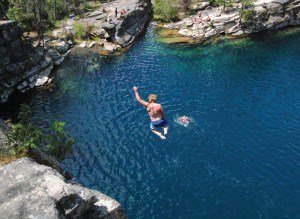
On a hot day there’s nothing more refreshing than plunging into a cold lake.
But if that jump comes from a great height, it could come with consequences: a few bruises, a broken back, a concussion or even drowning.
Horseshoe Lake is a gorgeous day use area in Jasper National Park that attracts locals and visitors alike.
On any given summer day, dozens of people will climb high above the water, coaxing themselves and their friends to jump in. Some days, the experience is full of laughter and cheers, while others are full of pain, panic and fear.
That was the case earlier this month when a woman jumped from the 80-foot cliff. Her landing was off and the result was head-to-toe bruising so painful that she couldn’t even work.
From 80-feet up, all it takes is one wrong move, a misplaced limb, a crooked back or a last minute flail, for things to go terribly wrong. That’s because from such great heights, the water below doesn’t soften your landing, it acts as a brick wall, waiting to be smashed.
Cliff jumping is an exhilarating summer activity, so it’s doubtful thrill seekers will heed warnings and stop participating, but there are a number of things to consider before taking that leap.
First, your skill level. Start low and practice your pencil dive—making your body as slim and straight as a pencil, with your arms by your sides, your legs pressed together and your feet pointing downward.
It’s important to remember that as you’re flying through the air, you pick up a lot of speed—speed which increases exponentially the higher you go—and without the proper body positioning, that speed can result in a high impact blow between your body and the water below. It’s those hard landings that end with compression fractures, spinal injuries, concussions and even death.
But, even if your landing is flawless, cliff jumping is still dangerous. Lakes and rivers often have hidden dangers below the surface that, if hit, can cause injury or death. So, before jumping, it’s important to inspect the water, ensuring it’s free of hidden obstacles and deep enough to sustain a long-haul leap.
It’s also key to remember you’re not jumping into a lake full of bathwater. Jasper’s lakes are frigidly cold and when you plunge into those chilled temperatures, it can cause your body to go into shock.
That shock, mixed with the disorientation of a forceful impact, can cause you to take a deep breath underwater, creating panic and increasing the chances of drowning.
To ensure a safe and healthy summer, it’s important to weigh the risks of all of our recreational activities.
Be smart this summer: think before you leap.
